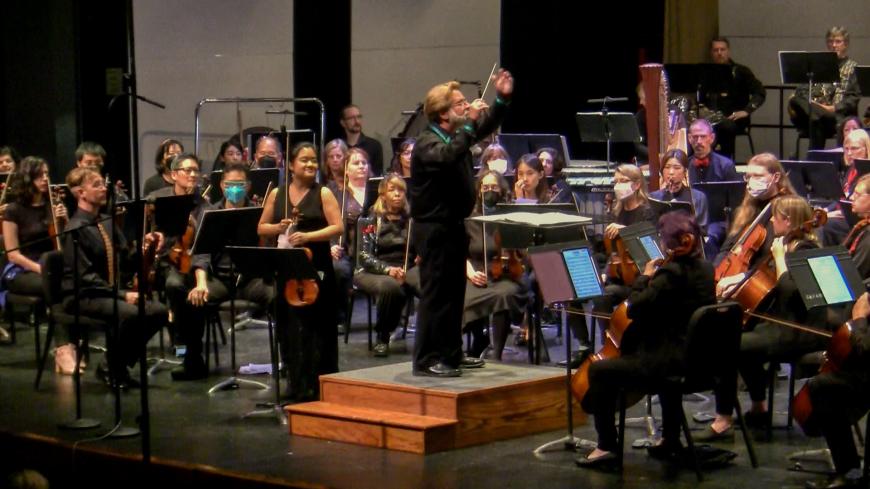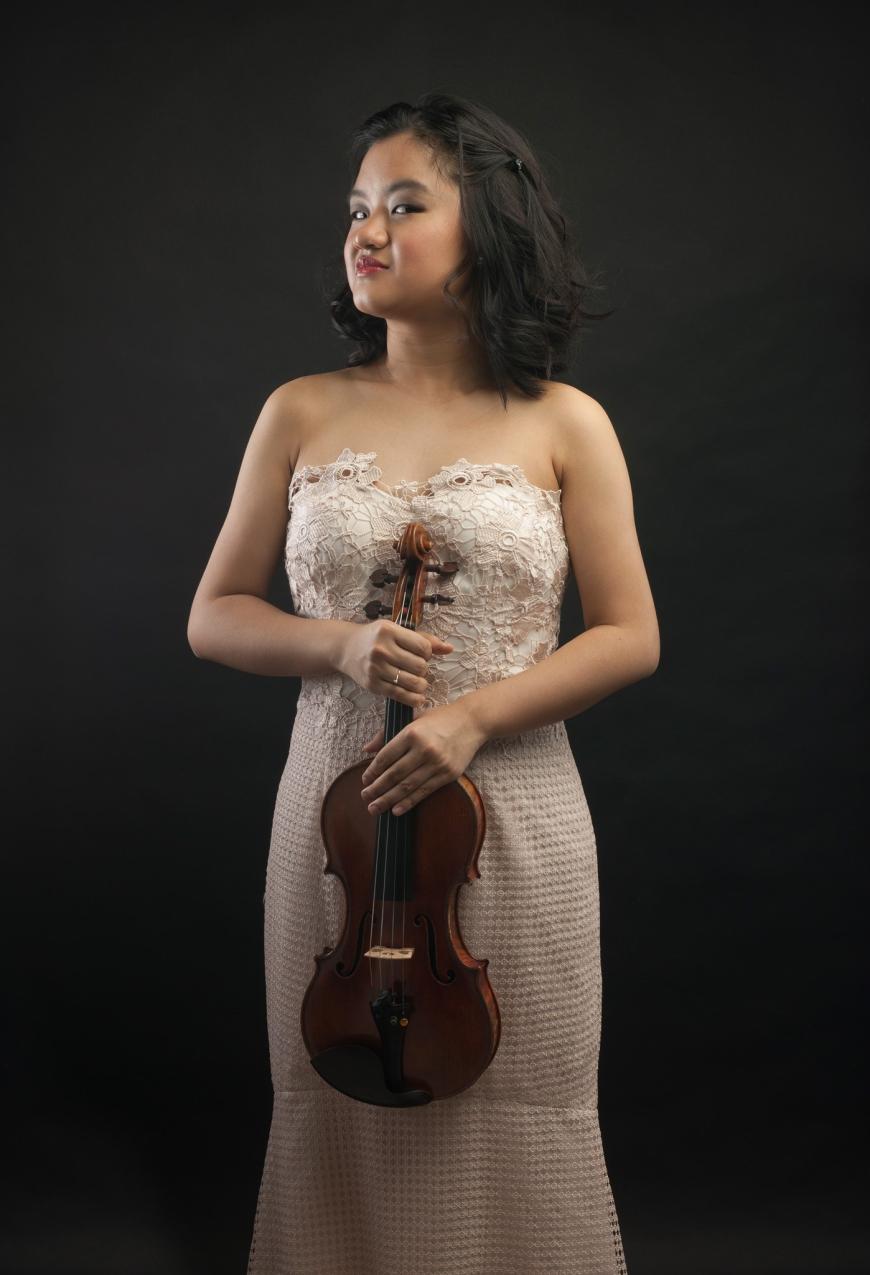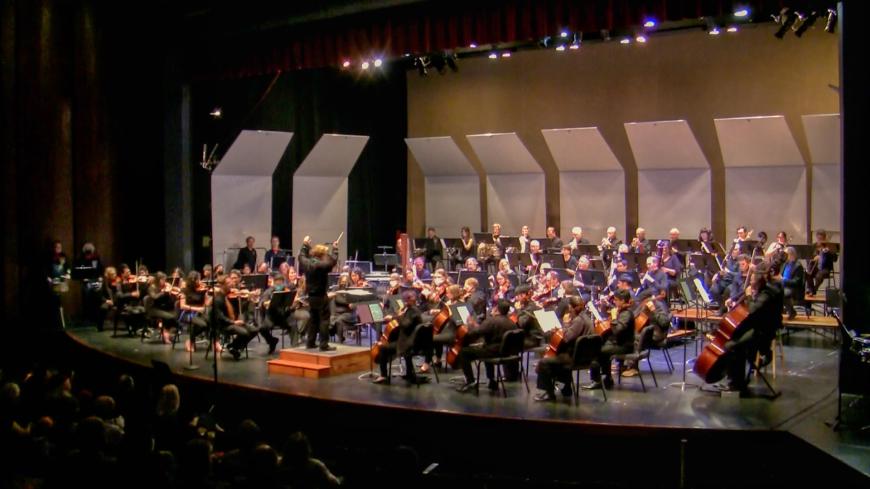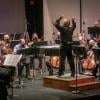
Redwood Symphony gave a bifurcated concert on Saturday, June 3 at Cañada College in Redwood City. Half the program was modern — mid-20th century or very recent — and moderately challenging, while the other half turned cheerfully and pugnaciously to popular classics. Music Director Eric K conducted most of the program.
The center of the concert, and by far its longest work, was Dmitri Shostakovich’s Violin Concerto No. 1, with Miranda Liu as soloist. This is one of the works Shostakovich wrote while in official disfavor in the Soviet Union’s later Stalin years. He kept it hidden in a drawer until after the dictator died. Though moderately spicy in its harmonies, it’s not experimental or alarming. It is, however, purely the violinist’s concerto. Except for a few bits in the Scherzo and finale, the orchestra might as well not be there, and indeed it disappears entirely for an extremely long solo cadenza, which doesn’t sound much different from the rest of the soloist’s part.

Throughout the concerto, Liu played with a smooth, even tone, producing a strong and lyrical line. Even when jumping into vehemence, her playing was controlled and careful. For an encore after enthusiastic applause, she offered a solo Bach movement composed almost entirely of double stops, a technique which received only moderate display in the concerto. This too was slow and eloquent.
Insofar as the orchestra had anything to say in accompanying the concerto, it felt a little tentative until the finale, when crisp wind response patterns caused the interplay between orchestra and soloist to snap together, finishing the music in a spirit of fellowship.
The orchestra’s assistant conductor, Kyle Baldwin, led the contemporary piece on the program, Shredding Glass by Rain Worthington. This was Worthington’s response to 9/11, an event that came close to her personally, as at the time she was employed in a building that was struck by the collapse of the South Tower in New York. She had left work a few hours before the attacks.
While many contemporary compositions responding to traumatic events do so by loudly conveying open anguish, Worthington takes a different approach. This is quiet music, though hardly gentle. Fragments of descending chromatic scales, played eerily with glissando effects or tremolo backing, convey the image of pieces of glass falling through the air. Strings play slowly oscillating harmonies or disappear entirely, leaving winds, very soft brass chords, and mallet percussion to carry the music.
The overall effect of Shredding Glass is one of awe and sorrow, well expressed by one critic as “an undercurrent of unresolved apprehension.” It conveys both unease and the composer’s desire for catharsis. It’s an interesting piece, and it stood strongly apart from the rest of the evening’s program.
Especially when it came to the concert’s other half, the popular classics. While the Shostakovich was also mostly quiet, and refrained from overemphasis when it was not, these other pieces achieved overwhelming volume. This impression was doubtlessly enhanced by the recent addition of another two panels to the acoustic shell behind the musicians. The Cañada College Main Theater is not a large space. Focusing the sound within it makes a tremendous impact.

This was obvious from the opening, Aaron Copland’s Fanfare for the Common Man for brass and percussion. The performance was ragged but exciting. It fairly boomed its way out to the audience.
Excerpts from Georges Bizet’s L’Arlésienne Suites Nos. 1 and 2 achieved a full-bodied heartiness through sheer volume and the faithful execution of all the repeats. Music that often comes across as light and fleeting sounded here like a series of lusty stomping dances.
The concert concluded with one of the most shameless display pieces ever written by a major composer, Maurice Ravel’s Boléro. Most serious orchestras don’t even perform this work, which hardly requires any interpretation at all. Its form — simply one giant crescendo — was emphasized by the performance style Saturday. Some of the opening wind solos felt wobbly and hesitant. By the end, the orchestra had erupted into a huge, confident roar. There was some extra backing at this point: I saw at least three snare drums rapping out the rhythm where Ravel calls for only two (in fact, Redwood Symphony says there were five). I wouldn’t be surprised if there was a little more enhancement of the orchestration elsewhere in the concert, too.


